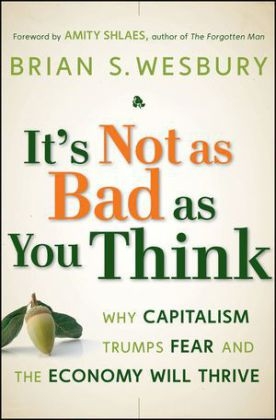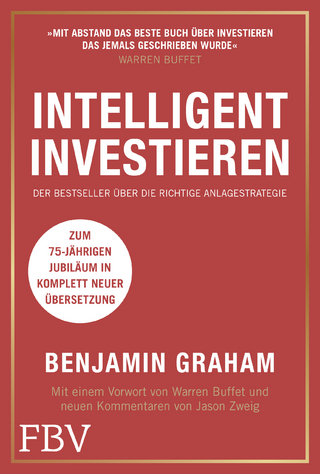
It's Not as Bad as You Think
John Wiley & Sons Inc (Verlag)
978-0-470-23833-2 (ISBN)
- Lieferbar (Termin unbekannt)
- Versandkostenfrei innerhalb Deutschlands
- Auch auf Rechnung
- Verfügbarkeit in der Filiale vor Ort prüfen
- Artikel merken
An upbeat antidote to the gloom and doom forecasts of the financial future
Just about everyone is worried about the economy and markets. And the fear is that they will stay down for a long time. But a few brave voices say that the gloom and doom forecasts are just too pessimistic. Reality is that entrepreneurs don't give up. History is pretty clear, every time the economy is thought to be done, worn out, finished, it bounces back and heads to new highs. In fact, the economy and the markets-counter to conventional wisdom-have started to improve in the first half of 2009. Even housing is showing some signs of life.
With It's Not as Bad as You Think, Brian Wesbury, ranked as one of the top economic forecasters by the Wall Street Journal and USA Today, shows you that while the financial future may be hard to predict, it will ultimately be profitable over the long haul. In this easy-to-follow and engaging forecast of the future, Wesbury takes a look at the good, the bad, and the ugly-and debunks the pouting pundits of pessimism to show you how to prosper now and in the future.
An optimistic look at the economy and the markets written by one of today's foremost financial forecasters
Presents a roadmap to seek opportunities in all the panic
Shows you how to analyze economic indicators and government policy to grow your wealth so you don't lose by hiding under the bed
A breath of fresh air, Wesbury's objectivity and optimism provide welcome relief to the daily bad news stories, as he sets us all up to capitalize on tomorrow's great possibilities.
BRIAN S. WESBURY is Chief Economist at First Trust Advisors LP, a financial services firm with over $23 billion under management. He writes frequently for the American Spectator magazine, serves as the magazine's Economics Editor, and is often a contributor to the Wall Street Journal editorial page. Wesbury was ranked as the nation's number one forecaster by the Wall Street Journal in 2001, and USA Today ranked him as one of the nation's top ten forecasters in 2004. Wesbury received an MBA from Northwestern University's Kellogg Graduate School of Management and a BA in economics from the University of Montana. His most recent writings can be found at www.ftportfolios.com.
Foreword ix
Introduction 1
Chapter 1 Getting the Right Perspective 9
Fear and Anger Are Understandable 12
History versus Emotion 18
Buck Up and Remember History 22
Chapter 2 Capitalism Wins (Again) 23
Demand versus Supply 24
The History of the World 29
Inventions and Innovation 32
Entrepreneurship 33
The Turning Point 35
Capitalism Wins—It’s Not Over 36
Chapter 3 Creative Destruction 39
The Big “X” 41
The Industrial Revolution 44
The Call for Change 47
A Wrong Drift, but a Cool Wind 49
Inflation, Creative Destruction, and the Crisis 51
Chapter 4 A Government-Sponsored Recession 53
The Housing Boom 56
The Crisis Begins 57
The Acceleration 60
Why in the World Were They Doing That? 61
So Why Blame Capitalists? 64
Chapter 5 Who Makes Your Glasses? 67
Are Consumers Rational? 68
What Is the Natural Rate of Interest? 70
Calculating the Natural Rate 72
The Nominal GDP Rule 74
Money and the Interest Rates 76
The Fed-Induced Bubble 77
We’ve Been Here Before 79
Stupid Bankers, or Not? 81
It Always Ends Badly: Volcker to the Rescue 82
Then . . . 84
. . . And Now 85
Chapter 6 Mark-to-Market Mayhem 87
Government Failure versus Market Failure 89
Some Mark-to-Market Accounting History 92
Mark-to-Market Creates Volatility 93
Suspend Mark-to-Market 99
A False Feeling of Control 101
A Miracle Happened 102
Chapter 7 Panic and the Speed of Money 105
What Recession? 107
The Panic of 2008 110
Mark-to-Market Mayhem 115
AIG, Credit Default Swaps, and Derivatives 117
The V-Shaped Light at the End of the Tunnel 120
Chapter 8 It’s Not as Bad as You Think 125
Consumer Spending 129
Debt 131
Growth, Debt, and China 135
Deleveraging 138
Unemployment 142
Savings Rates 143
The Economy Will Recover 144
Chapter 9 It’s Boom Time Again 147
Don’t Fight the Fed 150
1975 –1976 Redux? 151
Can It Happen Again? 153
Panics End 153
It Won’t Stay Down Forever 155
Undervalued Markets 156
Productivity and Profi ts 159
But Government Is Growing . . . 161
Chapter 10 Investing in the Midst of Mayhem 163
The Super-Easy Fed 165
Buy U.S. Stocks for the Short to Medium Term 166
Stocks for the Long Term: Small Cap, Value, and Momentum 169
Infl ation Plays for the Medium and Longer Term 171
Foreign Equities 174
Fixed Income 176
Emotion and Investing 180
Chapter 11 The New Normal 183
Big Government Hurts 188
Keynes and Government 190
How Bad Can It Get? 191
Roosevelt, Carter, or Clinton 192
The Future Still Looks Bright 195
Notes 197
Acknowledgments 203
About the Author 205
Index 207
| Vorwort | Amity Shlaes |
|---|---|
| Zusatzinfo | Drawings: 31 B&W, 0 Color |
| Verlagsort | New York |
| Sprache | englisch |
| Maße | 161 x 236 mm |
| Gewicht | 413 g |
| Einbandart | gebunden |
| Themenwelt | Sachbuch/Ratgeber ► Beruf / Finanzen / Recht / Wirtschaft ► Geld / Bank / Börse |
| Wirtschaft ► Betriebswirtschaft / Management ► Finanzierung | |
| ISBN-10 | 0-470-23833-X / 047023833X |
| ISBN-13 | 978-0-470-23833-2 / 9780470238332 |
| Zustand | Neuware |
| Informationen gemäß Produktsicherheitsverordnung (GPSR) | |
| Haben Sie eine Frage zum Produkt? |
aus dem Bereich


